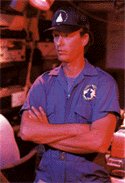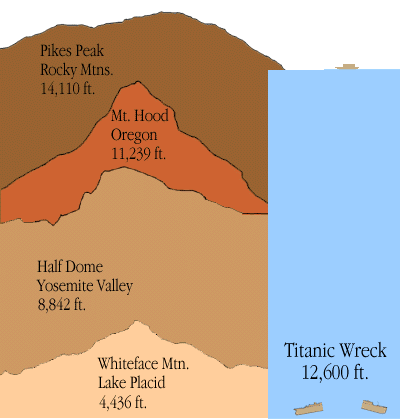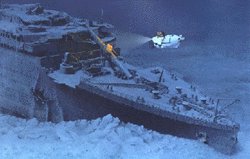


foreword
On an April morning in 1912, the world awoke to horrifying news. The R.M.S. Titanic, a large and lavish "unsinkable" new ocean liner, had struck an iceberg and sunk. More than 1,500 people had died in the freezing waters of the North Atlantic because Titanic had not carried enough lifeboats. "How could this happen?" was the question everyone asked.
On September 1, 1985, Titanic was in the headlines once again. That morning, a French-American expedition led by Dr. Robert Ballard had discovered the legendary lost ship. Titanic had been found sitting proudly upright on the ocean bottom, two and a half miles beneath the surface.
Robert Ballard and his team returned to Titanic in the summer of 1986. In a tiny three-man submarine they dived down to the icy black depths where Titanic lay. With Jason Junior, their tiny swimming robot, they explored and photographed the entire ship in detail. Dr. Ballard even sent Jason Junior down the ships Grand Staircase to get a closer look at chandeliers still hanging from the ceiling.
Here is the dramatic discovery.
© Copyright Ballard & Family 1988

-The first planned expedition was led by US entrepreneur Jack Grimm. They left on July 14, 1980 from Port Everglades, Florida on the H.J.W. Fay.
-On this expedition Grimm hired Fred Spiess and Bill Ryan, two of the top oceanographers in the world (at that time).
- Dr. Ballard's expedition to locate the wreck set out on July 5, 1985. His expedition was a joint French-American one. The French scientists were part of IFREMER (Institut Français de Recherches pour l'Exploration des Mers) while the Americans were part of the Woods Hole Oceanographic Institution (WHOI).
-Dr. Ballard suggested, after six weeks of searching, to search just north of the area where the lifeboats had been picked up by the rescue ship Carpathia.
-The two ships involved in the expidition were named Le Suroit and Knorr.
-They both used sonar tracking instruments to map the ocean floor. One of the instruments, "SAR" was a red, torpedo-shaped tracking device that covered an area of about 80 percent of the 150-mile target search area. It belonged to IFREMER.
-The second instrument, "Argo" was the instrument that found the wreck. It had less than 3/4 of the coverage area of SAR.
-A boiler from the ship was found on September 1st, 1985 at 1:05 AM.
-Titanic's wreck is located at a depth of 12,460 feet, two and a half miles underwater. At this depth, the water pressure is approximately 6000lbs. per square inch! It lies on a gently sloping alpine-like country side overlooking a small canyon below (now named Titanic Canyon). Its bow faces slightly east of north and sits upright.

-One mystery was solved by finding the wreck, the ship was torn in two, between the third and fourth funnels.
-When Dr. Ballard returned in 1986, he explored the wreck, as well as the debris field in his three-man submarine christened Alvin.

-Unfourtantely the first sight of Titanic he saw lasted less than 5 minutes. It was of her massive hull rising from the mud below. "I thought of Edmund Hillary standing at the summit of Mount Everest, of some future space traveler peering over the edge of the known universe. Slowly, I let out my breath; I didn't realize I had been holding it." -Dr. Robert Ballard
-The stern was located approximately 1,970ft. away from the bow.
-There is a hole in the bow (see image above) that many would like to believe to have been caused by a coal explosion, and helped Titanic sink. If I had a bigger image to show you, you would see that the hole is way too high above the waterline for it to have helped sink Titanic. A more realistic story would be that the hole was caused by the immense stress caused on the hull while it was tilted at an unusual angle. Or perhaps it was caused when the bow plowed into the mud on the sea floor.
-The forecastle of the bow was buried more than 60ft. in the mud.
-Only the top part of the biggest propeller is visible above the mud.
-The crow's nest, where the iceberg had been spotted, was still attached to the foremast which had fallen over onto the deck of the bow.
-Both anchors were still in place.
-A lighting fixture in the Grand Staircase area was found intact with a piece of coral growing out of it.
-No human remains were ever found at the wreck site. The only explanation for this is possibly because the mud on the sea floor has an acidic level of PH 4! (That's the same strength as the acid in your stomach)
-An eerie doll's head, resembling a human skull, was found looking up from the silt. It might have belonged to Loraine Allison of Montreal. The only first class child not saved in the sinking.
-Many objects were found in the debris field lying between the separated stern and bow section. These objects remind us that this is a grave site, and should not be disturbed.
-Dr. Ballard made 7 dives before returning home for the last time. He is part of the Woods Hole Oceanographic Institution in Massachussets.
-He left a plaque in memory of those who lost their lives during that fateful night. He did not disturb anything in the wreckage.
-The stern section sits on the ocean bottom at 49º 56' 54" W, 41º 43' 35" N and the center of the debris field is at 49º 56' 49" W, 41º 43' 32" N. The center of the bow section is located at 49º 56' 54" W, 41º 43' 53" N.
The Construction The Sinking Timeline Downloads Links Awards Webrings